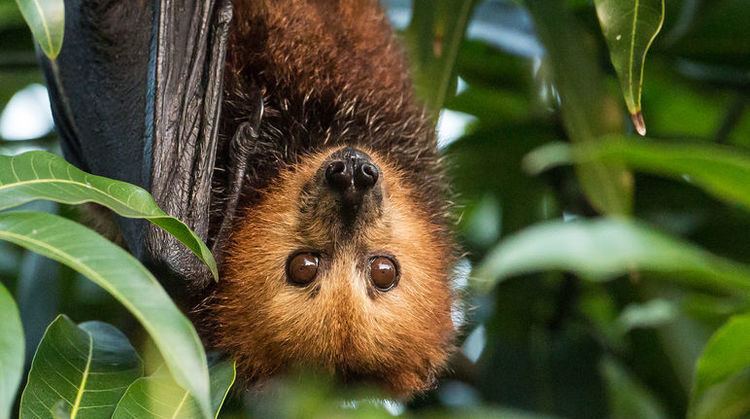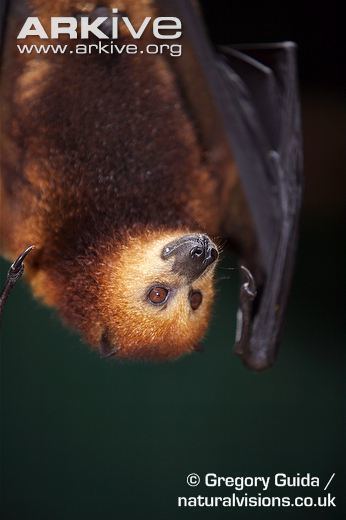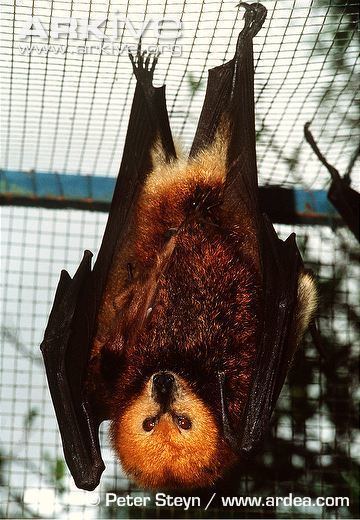Order Chiroptera Higher classification Flying foxes | Scientific name Pteropus niger | |
 | ||
Similar Flying foxes, Small Mauritian flying fox, Megabat, Masked flying fox, Black‑bearded flying fox | ||
Mauritian flying foxes or golden bats love papaya
The Mauritian flying fox (Pteropus niger), also known as Greater Mascarene flying fox or Mauritius fruit bat is a large megabat species endemic to Mauritius and La Réunion.
Contents
- Mauritian flying foxes or golden bats love papaya
- Description
- Origin
- Location
- Ecology
- Habitat
- Threats
- References

Description

It can reach a wingspan of 80 cm, so is the largest endemic mammal on Mauritius. Its fur is golden. It has small ears, thick hair on the tibiae, dorsal coloration of glossy, blackish brown mantle, tinged with rufous, which extends posteriorly into a dark brown median spinal tract, flanked by buff lateral patches. It is a medium-sized species; the adult forearm length averages 152 mm, with no difference between males and females. Mostly nocturnal, although some are occasionally seen during the day, they normally roost by sunrise. These fruit bats range in size from 40-800 g and occur from sea level to 1500 m above.
Origin

Representative samples of flying foxes (genus Pteropus) in the Philippines came from different islands of the country. The split of Pteropus species from their megabat relatives was between 28.37 and 34.63 million years ago. Within the genus, the first evolutionary event arose probably between 12.41 and 15.39 million years ago.
Location

Fruit bats, such as the P. niger, are extremely important to the Western Indian Island ecosystems. Their role in these ecosystems is as pollinators and seed dispersers. P. niger currently resides on the island of Mauritius, and is now extinct on the island of Réunion.
Ecology

They roost in large groups and are active at dusk and dawn. Their diets consist of fruit and nectar, making them important seed dispersers and pollinators.

P. niger is a pollinator and seed dispenser. As less than 1.9% of the island supports native vegetation, and reproduction of plant species is poor, the survival of this species is important to the ecosystem as whole. One study (conducted from October 1999 to April 2000) looked at two large roost areas in Bel Ombre, each consisting of at least 400 individuals. No roosts of the bats exist in village areas. The bats are mostly located in the Bel Ombre forest, with some smaller populations in the Combo Forest and Black River Village.

It consumes mostly fruit and some fauna, when available or absolutely necessary. The study found the bats consumed 20 species of plants, 18% of which were native to Mauritius. Of those native species, 36% are either vulnerable or rare. The bats dispersed many seeds from these plants in flight through their feces. This is ultimately advantageous to many of the native species (mostly fruit species, which make up the majority of the bats' diets) They also found P. niger is an opportunistic feeder, mostly adapting to and eating whatever plants or fruits are available to it at the time. While little evidence supported P .niger as valuable in the pollination process, its role as a seed dispenser is important to the survival of many species of plant life on Mauritius.
Habitat
It occurs in the forests within the national parks of Black River Gorges, Combo and Bel Ombre. Occasionally, it can also be found in fruit plantations, which causes conflicts with the farmers.
Threats
The Mauritian flying fox was once widespread on the Mascarenes. On Reunion, it became extinct between 1772 and 1801. Their closest extant relative occurs on Rodrigues and is very rare. On Mauritius, it was severely affected by deforestation and hunting. Even in 1974, 1000 specimens were shot annually. A cyclone devastated the population, but it slowly recovered to an estimated 20,000 animals in 2006. Currently, the population is regarded as stable by the IUCN; however, in September 2006, the Government of Mauritius decided to initiate culling of animals. This is controversial, though, as it may leave the species vulnerable to extinction.. In an effort to rescue the species, the Organization for Bat Conservation has included the bat in an international conservation project.
In October 2015, the Mauritian government declared that the population of P. niger had reached a threatening 100 000. Widespread anger and protest among fruit farmers erupted, leading Parliament to approve the culling of 20 000 bats by the Special Mobile Force. This initiative was widely criticised by International Conservation agencies, which questioned the counting process and true efficiency of the culling.
P. niger is listed as vulnerable; of the eleven species of fruit bats in the Indian Ocean, only the related P. subniger is extinct. The “continued survival of the western Indian Ocean fruit bats [is] imperative for the conservation of the region’s biodiversity”. These islands are affected by human-induced environmental degradation and natural events such as cyclones, which remove the natural vegetation and blow unprotected bats into areas of poor cover or out to sea. These factors have led to the extinction of one species, and five of the eleven species are threatened.
